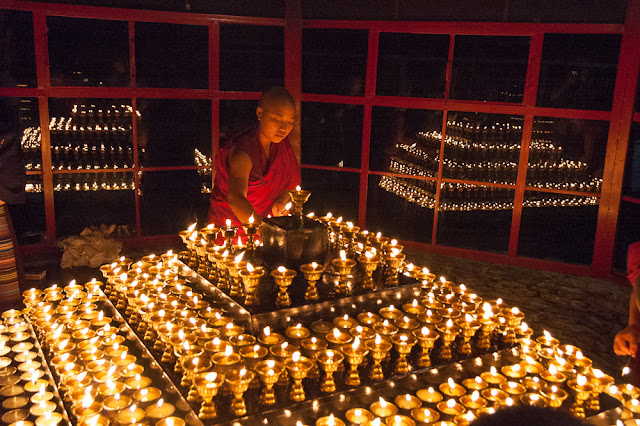May this virtue be helpful for my emancipation;
Just as these flowers fade,
Our body will undergo decay.
In Buddhism, symbolic offerings are made to the Triple Gem, giving rise to contemplative gratitude and inspiration. The type of material offerings involve simple objects such as a lit candle or oil lamp, burning incense, flowers, food, fruit, water.
Why we give offerings to the Enlightened ones -The Buddhas?
The Buddhas and the Enlightened beings they do not requiring these kind of offerings. We make these offerings is for accumulation of merits and wisdoms, enlightenment, Buddha hood, is achieved through these great qualities - accumulation and purification. As we knew the Buddhas had limitless of qualities which were attained through these two mentioned qualities.
The act of offering is an act of Dana. An act of generosity to the:-
- Buddha himself – the Perfectly Enlightened One.
- To the Dharma – the Truth.
- To the Noble Enlightened Ones-the Great Compassion of Bodhisattvas.
In the Vajrayana and Mahayana traditions, flower offerings might be imbued with the following indications:-
Flowers are the most beautiful things in the world, we are offering the most beautiful things in the world to the Buddhas. When they fade, it is also a reminder those things of the world also fade, it has reminded us of the teaching that “Whatever is of the nature to arise is also of the nature to cease”.
Flowers are the most beautiful things in the world, we are offering the most beautiful things in the world to the Buddhas. When they fade, it is also a reminder those things of the world also fade, it has reminded us of the teaching that “Whatever is of the nature to arise is also of the nature to cease”.
Flowers represents the aspiration to achieve the body of the Buddha with the thirty-two marks of the Buddha as well as the teaching of impermanence.
From the sutra Distinguishing the Aspects of Karma (Lanam Je): There are ten benefits of offering flowers to the Buddhas, statues, stupas, scriptures, holy places and monastery.
- One becomes like a flower in the world. (You will be very beautiful; everyone will be attracted and amazed to look at you and will remember seeing you.)
- The sense of smell will never degenerate. (Some people have sicknesses in the nose so that the sense of smell doesn’t function.)
- One will never have bad body odor. (This will be completely purified.)
- A smell of scented nectar will come from the body.
- The smell of the morality of the person will spread in all directions and corners.
- One will be a leader of the world. (One will be a leader of people, of the world, of holy beings.)
- One will achieve beautiful attractive things.
- One will have great wealth.
- One will be reborn in a higher rebirth.
- One will quickly achieve the sorrow less state and achieve enlightenment, the great liberation.
Aspiration For Bodhichitta
For those in whom the precious Bodhichitta has not arisen
May it arise and not decrease
But increase further and further.
Dedication of Merit
By this merit may we obtain omniscience then.
Having defeated the enemies wrong-doings.
May we liberate migratory from the ocean of existence.
With its stormy waves of birth, old age, sickness and death.
*Note
I do not own or infringe any copyright of these pictures.
Pictures courtesy and credit to the rightful distributors and or studios.
Pictures are intended for editorial use only.








































